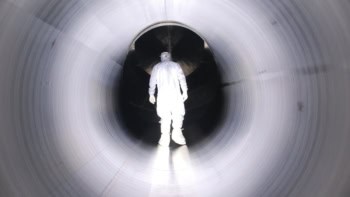The Sudbury Neutrino Observatory (SNO) in Canada was officially opened this week. SNO will be the first detector capable of distinguishing between the three types of neutrino - electron, muon and tau neutrinos - and could finally resolve if these mysterious particles have mass or not. This is one of the outstanding questions in physics. The observatory, a joint project between Canada, US and UK, is a 1000-tonne tank of ultrapure heavy water located 2000 meters underground in a nickel mine in Ontario.
Neutrinos travel at the speed of light and only interact very weakly with matter, which makes them very difficult to detect. This is why neutrino detectors need to be large and built underground – otherwise cosmic ray interactions will mimic the neutrino signal. When a neutrino does interact with the heavy water in the tank, a flash of Cerenkov radiation is emitted and recorded by some of the 10000 photomultiplier tubes that surround the tank.
Astronomers hope that the observatory will help solve the solar neutrino problem – the fact that existing experiments detect less than half the flux of neutrinos from the Sun predicted by theory. One possible explanation is that electron neutrinos are oscillating into muon neutrinos that cannot be detected by the other experiments – but this would require neutrinos to have a non-zero mass, which would have enormous implications for particle physics and cosmology. The observatory should also be able to detect neutrinos from other astronomical events such as supernova explosions.
The opening ceremony was broadcast over the Internet and included remarks from Stephen Hawking and two Nobel prize-winners – Bertram Brockhouse and Richard Taylor.



